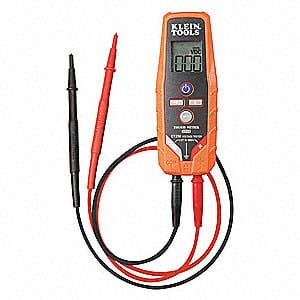The proliferation of electronic navigation, communication, power and security systems on modern yachts demands a dependable means of diagnosing these systems when they fail or fall short in performance. The best, most versatile tool for this job is a high-quality, digital, electrical multitester, also referred to as a multimeter.
Until recently, very few manufacturers offered waterproof, drop-resistant, highly accurate multimeters suitable for the offshore sailing yacht. The Fluke series of electrical testing units, known for their yellow rubber jackets, were virtually the only choice for the offshore sailor — and a rather expensive one. Today, there are numerous well-constructed multitesters up to the demands of ocean cruising, and most are well within the budget of the cost-conscious cruiser.
The Sperry DM8700 Techmaster digital multimeter is a rugged, professional electrical tester capable of reading current up to 20 amps AC/DC. A 20-amp, 600-volt fuse protects the device from virtually any electrical surge to be encountered on a sailing vessel. The unit is water resistant (not fully waterproof) and drop-proof to 10 feet. At roughly $200, the DM8700 is not exactly cheap, but certainly reasonably priced.
The Extech EX505 heavy-duty autoranging digital multimeter is an industrial, waterproof, drop-resistant device capable of measuring AC/DC voltage (1,000 volts), current (10 amps), resistance (40 megaohms) and capacitance (100 microfarads). Additionally, this unit includes a Type K temperature probe that measures from -4° F to 1,382° F, a capability not likely to be important to an ocean sailor — but who knows?
Along with the temperature probe and standard pair of test leads, the EX505 comes with a magnetic hanging strap, carrying case and 9-volt battery. Not a bad choice, especially when you consider a price tag of around $100.
A particularly good value is the Klein ET250 AC/DC voltage/continuity tester, which measures up to 600 volts AC/DC and may be used to test the function of GFCI-protected circuits, such as electrical outlets. Incidentally, all AC outlets on ocean vessels should be GFCI-protected to ensure the safety of both vessel and crew.
An interesting feature of the ET250 is its test connections, which are inserted into the base of the unit rather than the face, permitting easier storage in a tightly packed toolbox. The ET250 is drop-proof to 9.8 feet and rated IP53 dust/water resistant. At roughly 50 bucks, this device offers a lot while setting us back very little.
And of course, we have the venerable line of Fluke multimeters, which are generally regarded among electricians as the top of the line. The Fluke 28 II is fully waterproof and impact resistant up to a 10-foot drop, ideally suited for the offshore yacht. It also floats when stored in its yellow rubber holster. The Fluke 28 II measures up to 1,000 volts AC/DC, and up to 10 amps (20 amps for 30 seconds).
Running on three AA batteries, the Fluke 28 II boasts backlit keypad buttons, large display digits, and two-level bright white display backlighting for easy visibility in low-lit areas.” The unit sells for about $450, which is significantly higher than other devices in its class, but well worth the expense if you want the ultimate in dependability.
As a final note, waterproof rating is ideal but perhaps overrated. We generally test electrical circuits inside the cabin, and when we do use the multimeter out on deck, it is usually in settled conditions, most likely at anchor. Whichever multimeter you select, make sure it is drop resistant and at least water resistant, if not fully waterproof.
Circumnavigator-author Bill Morris is the author of Sun, Wind, & Water: The Essential Guide to the Energy-Efficient Cruising Boat and is a frequent contributor to Ocean Navigator.

